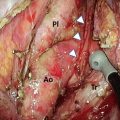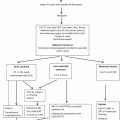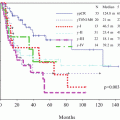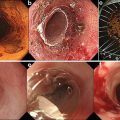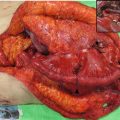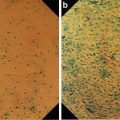Fig. 1.1
Age-standardized incidence rate (World) of esophageal cancer in the world (2008)
Esophageal cancer is two to four times more common among men than women in general; however it is approximately seven times more common among men in Japan and 17 times more common among men in Korea. These differences in sex ratio may suggest different etiologies by region. In Japan and Korea, tobacco smoking and alcohol drinking are assumed to be major causes of esophageal cancer and the predominant incidence rate among males is associated with much higher prevalence of smoking of tobacco and alcohol use among men versus women. In China and Southern Africa, an important risk factor, in addition to tobacco smoking and alcohol drinking, is thought to be nutrient deficiency such as vitamins and micronutrients, which occurs equally in both men and women. However, the apparent reason of geographic variations is unspecified.
1.1.1.2 Histological Type [2]
In those high-incidence regions that provide information on histological type, approximately 90 % are squamous cell carcinomas (Fig. 1.2). This is in contrast to some lower-risk populations, such as Caucasian Americans and Europeans, where adenocarcinomas are predominant. For example, in the USA, SEER (non-Hispanic White) indicated ASR 5.3 in men where 67 % of cases are coded as adenocarcinoma as opposed to 25 % squamous cell carcinoma. In contrast, Japan, Nagasaki indicated ASR 9.1 in men where only 2 % of cases are coded as adenocarcinoma as opposed to 93 % squamous cell carcinoma.
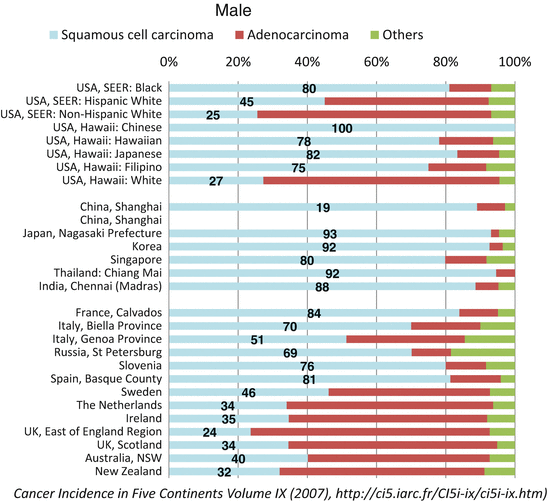

Fig. 1.2
Esophageal cancer—histological distribution % (1998–2002)
1.1.2 Esophageal Cancer in Japan
In 2011, 10,141 men and 1,829 women died from esophageal cancer, representing 4.8 and 1.3 % of the total cancer death in men and women, respectively. Mortality rates increased with age rapidly after 40 years (Fig. 1.3). The mortality rate of esophageal cancer is estimated to be 0.67 % in men and 0.09 % in women up to 75 years, increasing to 1.17 % in men and 0.20 % in women over lifetime. Regarding incidence, 17,004 men and 2.990 women were estimated to be diagnosed with esophageal cancer in 2007 and the probability of esophageal cancer diagnosis was 1.35 % in men and 0.19 % in women up to 75 years, increasing to 2.16 % in men and 0.43 % in women for lifetime. Five-year survival rates were 32.3 % in men and 41.3 % in women who were diagnosed with esophageal cancer in 2003–2005 based on the population-based cancer registry.
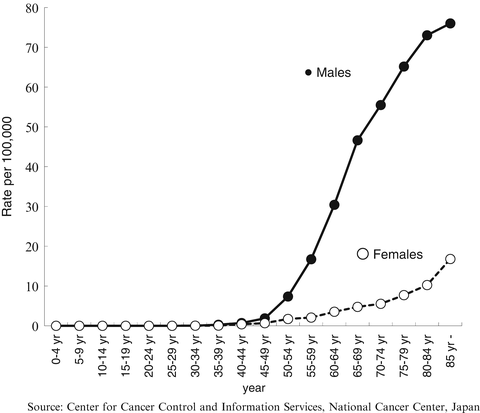

Fig. 1.3
Age-specific mortality rate of esophageal cancer in Japan (2011)
Both incidence and mortality rates are observed to have increased in number since 1960 due to the aging of Japanese population, while age-standardized rates are observed to have been consistently decreasing with the exception of the increasing male incidence rate (Fig. 1.4). Histological distribution trends were analyzed using eight population-based cancer registries with high level of reliability from 1993 to 2001 (Table 1.1) [3]. Squamous cell carcinoma remains the predominant type of esophageal cancer in Japan, and a remarkable increase in adenocarcinoma has not been observed before 2001. Disparity in the classification of esophageal and gastric cardia adenocarcinoma may have led to underestimation of esophageal adenocarcinoma incidence.
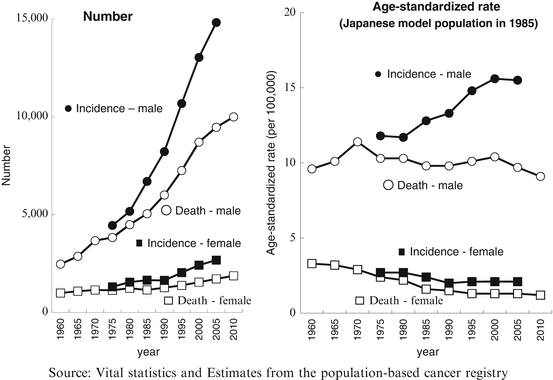

Fig. 1.4
Time trends in the incidence and mortality of esophageal cancer in Japan
Table 1.1
Trends in incidence of esophageal cancer by histological subtype in Japana
Males | Females | |||||
|---|---|---|---|---|---|---|
1993–1995 | 1996–1998 | 1999–2001 | 1993–1995 | 1996–1998 | 1999–2001 | |
Total number (%) | 4,819 (100) | 5,734 (100) | 6,360 (100) | 990 (100) | 1,033 (100) | 1,157 (100) |
Histology | ||||||
Squamous cell | 3,496 (72.5) | 4,277 (74.6) | 4,629 (72.8) | 661 (66.8) | 686 (68.6) | 750 (64.8) |
[% among specified histology] | [94.3] | [94.1] | [93.3] | [94.3] | [93.1] | [91.0] |
Adenocarcinoma | 125 (2.6) | 146 (2.5) | 192 (3.0) | 19 (1.9) | 28 (2.7) | 41 (3.5) |
Other types | 87 (1.8) | 120 (2.1) | 140 (2.2) | 21 (2.1) | 23 (2.2) | 33 (2.9) |
Unspecified | 1,111 (23.1) | 1,191 (20.8) | 1,399 (22.0) | 289 (29.2) | 296 (28.7) | 333 (28.8) |
An increased trend of adenocarcinoma of the esophagogastric junction was observed among patients who had underwent surgery for advanced gastric adenocarcinoma in the National Cancer Center Hospital in Tokyo, from 2.3 % in 1962–1965 to 10.0 % in 2001–2005; however the proportion of Siewert type I (defined as adenocarcinoma of the distal esophagus) had remained very rare (approximately 1 % among adenocarcinoma of the esophagogastric junction) [4]. Since this finding was confined to operative cases with advanced gastric adenocarcinoma, the proportion of Siewert’s type I tumors may have been underestimated.
1.2 Risk Factors
Established risk and protective factors for esophageal cancer are listed according to the level of certainty (Table 1.2). Tobacco smoking and alcohol consumption are convincing risk factors for esophageal cancer, especially squamous cell carcinoma. Mate, a traditional herbal beverage consumed in parts of South America, has been identified as a probable cause of esophageal cancer. Non-starchy vegetables, fruits, and foods containing beta-carotene and/or vitamin C probably prevent esophageal cancer.
Table 1.2
Established risk and protective factors for esophageal cancer
Evidence | Risk factors | Protective factors |
|---|---|---|
Convincing | Tobacco smokinga | – |
Alcohol consumptionb,c (squamous cell carcinoma) | ||
Body fatnessc (adenocarcinoma only) | ||
Probable | Matec | Non-starchy vegetablesc |
Fruitsc | ||
Foods containing beta-carotenec | ||
Foods containing vitamin Cc | ||
Limited–suggestive | Red meatc
Stay updated, free articles. Join our Telegram channel
Full access? Get Clinical Tree
 Get Clinical Tree app for offline access
Get Clinical Tree app for offline access

|
